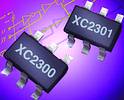Tri-state buffer ICs from Torex give a boost to handheld performance
18 June 2003
Telecoms, Datacoms, Wireless, IoT

Torex Semiconductor has introduced a new pair of compact tri-state output buffer ICs. The XC2300 and XC2301 have built-in input amplifier and divider circuits, and are claimed to provide a low cost yet highly efficient and flexible solution for a wide range of buffer applications. They are particularly suited to improving the performance of VCXO modules and crystal oscillator circuits found in handheld and portable equipment such as mobile phones, PDAs and laptop computers.
The XC2300 and XC2301 are low power CMOS buffers with maximum operating frequencies of 70 and 160 MHz respectively. Both are supplied in a compact mini-mould SOT-26 package. The XC2300 is available with a choice of operating voltage: either 3,3 V ±10% or 5,0 V ±20%. The XC2301 meanwhile is offered with an operating voltage of 3,3 V ±10%.
For both the XC2300 and XC2301 output is selectable from input frequency (fin) of: fin1, 2,4 and 8. So, for example, from an input of 160 MHz with the XC2301, typical output frequencies of 160, 80, 40 and 20 MHz can be achieved.
For more information contact Prime Semiconductors, 011 447 6527, [email protected]
Further reading:
What does Wi-Fi 7 mean for South African networks?
Telecoms, Datacoms, Wireless, IoT
With Wi-Fi 7 (802.11be), we are finally looking at a standard that was built, not just for more devices, but for the new way networks are used.
Read more...
Multiprotocol wireless SoC
RF Design
Telecoms, Datacoms, Wireless, IoT
The nRF54LM20A from Nordic Semiconductor is a multiprotocol wireless System-on-Chip designed for demanding designs in Bluetooth devices.
Read more...
High performance communication
iCorp Technologies
Telecoms, Datacoms, Wireless, IoT
Quectel’s FCS950R is a high-performance Wi-Fi 5 and Bluetooth 4.2 module that can deliver a maximum data rate up to 433,3 Mbps in 802.11ac mode.
Read more...
Expanded STM32WL3x line for IoT sensors
Altron Arrow
Telecoms, Datacoms, Wireless, IoT
The STM32WL31x and STM32WL30x are more tailored versions of the STM32WL33x for designers who wish to focus on specific features, while lowering their bill of materials.
Read more...
Full-band GNSS helical antenna
RF Design
Telecoms, Datacoms, Wireless, IoT
A key feature of Calian’s HC3990XF antenna design is that it does not require a ground plane, making it ideal for size-constrained applications.
Read more...
BLE and BT Mesh module
iCorp Technologies
Telecoms, Datacoms, Wireless, IoT
The HM-BT4531 from HOPERF is a BLE data transmission module that features an ARM Cortex-M0 32-bit processor.
Read more...
Espressif entering the Wi-Fi 6E market
iCorp Technologies
Telecoms, Datacoms, Wireless, IoT
Espressif Systems is entering the Wi-Fi 6E market, extending its connectivity portfolio into the domain of high-throughput, low-latency wireless solutions.
Read more...
Ultra-low jitter clock buffers
Altron Arrow
Telecoms, Datacoms, Wireless, IoT
New SKY53510/80/40 family of clock fanout buffers from Skyworks are purpose-built for data centres, wireless networks, and PCIe Gen 7 applications.
Read more...
Cutting-edge broadband power amplifier
RFiber Solutions
Telecoms, Datacoms, Wireless, IoT
Designed for high efficiency and reliability, the WPGM0206012M from WAVEPIA is a cutting-edge broadband GaN MMIC power amplifier operating from 500 MHz to 8,5 GHz.
Read more...
The trends driving uptake of IoT Platform as a Service
Trinity IoT
Editor's Choice Telecoms, Datacoms, Wireless, IoT
IoT platforms, delivered as a service, are the key that will enable enterprises to leverage a number of growing trends within the IT space, and access a range of benefits that will help them grow their businesses.
Read more...


